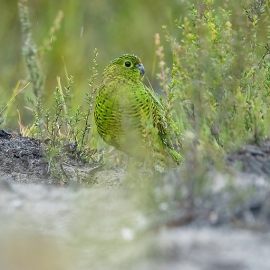Eastern Ground Parrot |
|
|
Also known as: Swamp Parrot, Buttongrass Parrot
Photos
View in GalleryDid You Know?
Ground parrots will tend to occupy their favourite habitats (heathland) one year after fire has been through, begin nesting in 4 years, are at peak densities (populations) between 8 to 10 years and then decline, with total abandonment of an area after 20 years.Academic Research
Related publications: Pezoporus wallicusSpecies Profile
Genus: Pezoporus | Species: wallicus
Size:
30cm (11.7 in)
Weight:
68-83g (2.4-3 oz)
Subspecies including nominate:
one
Colour Adult:
Slim, bright green parrot with long tail and red frontal band.
Male-bright green dotted with black and yellow; orange/red frontal band; green cheeks, ear coverts and throat all the way down to the breast, with black streaking on the feathers; abdomen to flanks and undertail coverts green/yellow, barred across black/brown; pale yellow spot on primary feathers and two spots on secondary feathers which form stripes; tail green barred with yellow and brown/black. Bill brown/grey, eye yellow. Female-as in male but with black shaft streaking to feathers of cheeks, ear coverts and throat to the breast.
Colour Juvenile:
As in adults but duller yellow/green with orange frontal band absent; feathers of cheeks, ear coverts and throat to breast black in centre. Tail shorter. Eye brown.
Call:
Calls before dawn and after sunset, with three or four bell sounding notes followed by sharper notes on ascending scale and terminating with drawn-out note.
Listen NowVideo Links:
Video 1 | Video 2More Information:
Content Sources:
CITES
BirdLife International
Cornell Lab of Ornithology/Birds of the World
Parrots: A Guide to Parrots of the World, Juniper and Parr, 1998
xeno-canto Eastern Ground Parrot, Aberg, Patrik XC98180
Parrots of the World, Forshaw and Cooper, 1989. 2010 edition
Parrots of the World, Forshaw, 2006
Lexicon of Parrots, Thomas Arndt.
Photos
View in GalleryDid You Know?
Ground parrots will tend to occupy their favourite habitats (heathland) one year after fire has been through, begin nesting in 4 years, are at peak densities (populations) between 8 to 10 years and then decline, with total abandonment of an area after 20 years.Academic Research
Related publications: Pezoporus wallicusSpecies Care
Captive Status:
Not found in captivity outside of Australia.
Longevity:
Not recorded.
Housing:
Spacious outdoor flight (in warm climates).
Diet:
Seed mix of grasses and millets, canary grass seed, some oats, niger; wild bird food, weed seeds and hemp; millet sprays; greens (chickweed, thistle, dandelion, kale); soft foods such as eggs and insects for rearing.
Enrichment:
Not recorded.
Nest Box Size:
Not recorded.
Clutch Size:
2 to 6
Incubation Time:
About 21 days.
Fledging Age:
20-28 days
Hatch Weight:
Not recorded.
Peak Weight:
Not recorded.
Weaning Weight:
Not recorded.
Photos
View in GalleryDid You Know?
Ground parrots will tend to occupy their favourite habitats (heathland) one year after fire has been through, begin nesting in 4 years, are at peak densities (populations) between 8 to 10 years and then decline, with total abandonment of an area after 20 years.Academic Research
Related publications: Pezoporus wallicusSpecies Wild Status
World Population:
About 100,000, decreasing.
IUCN Red List Status:
Least Concern
CITES Listing:
Appendix I
Threat Summary:
Affected by loss of habitat through urban development or agricultural development, therefore range is fragmented.
Range:
Scattered along coastal SE Australia from Fraser Island and Maryborough district in SE Queensland, south to S Victoria and possibly SE S Australia; also Tasmania, Hunter Island and formerly Flinders Island in Bass Strait.
Habitat:
Found in both heathland and sedgeland; temperate and subtropical shrubby heath with thick cover.
Wild Diet:
Feed on a variety of seeds but mainly Restionaceae, plus leaves, shoots and small insects.
Ecology and Behaviour:
Mainly sedentary and live in pairs, protecting their territories. Is active through the day with peak periods at dawn, mid-morning and late afternoon. Feeds on the ground.
Clutch and Egg Size:
2 to 6 slightly spherical eggs, 28.0 x 22.0mm (1.1 x 0.8 in).
Breeding Season:
Probably July-December. Nest is a shallow scrape in soil lined with stalks or leaves, in the base of a grass tussock or bush and hidden in a tunnel of vegetation.
Related Links:
Wikipedia
Research: Managing the Ground Parrot in its fiery habitat in south-eastern Australia
Research: Molecular systematics of two enigmatic genera Psittacella and Pezoporus illuminate the ecological radiation of Australo-Papuan parrots
Photos
View in GalleryDid You Know?
Ground parrots will tend to occupy their favourite habitats (heathland) one year after fire has been through, begin nesting in 4 years, are at peak densities (populations) between 8 to 10 years and then decline, with total abandonment of an area after 20 years.Academic Research
Related publications: Pezoporus wallicusMembers Only Resources
Please log-in now to find more research, resources and tools.
Not a Member?
Find more great information:
Gain exclusive access to 600+ pages of additional research, seminars and podcasts, specialists to ask your toughest questions, and dozens of other fun resources - when you become a WPT member.
Join Today >>

































